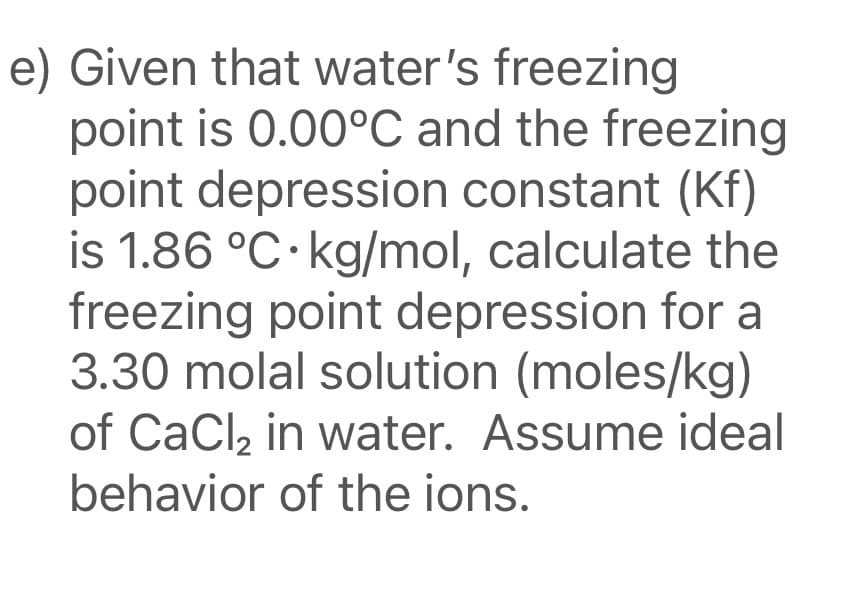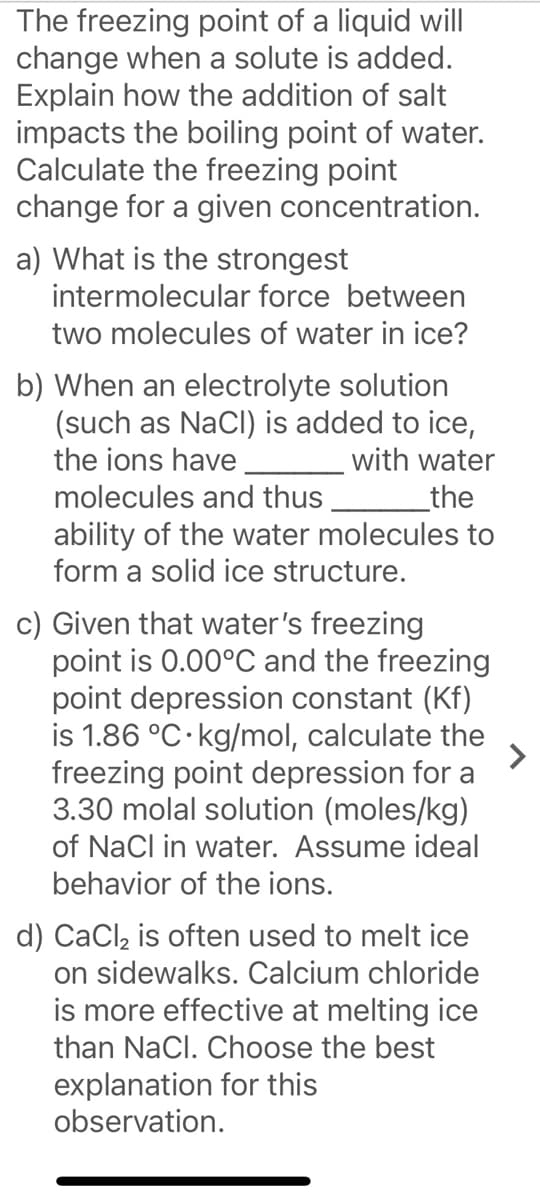General Chemistry - Standalone book (MindTap Course List)
11th Edition
ISBN:9781305580343
Author:Steven D. Gammon, Ebbing, Darrell Ebbing, Steven D., Darrell; Gammon, Darrell Ebbing; Steven D. Gammon, Darrell D.; Gammon, Ebbing; Steven D. Gammon; Darrell
Publisher:Steven D. Gammon, Ebbing, Darrell Ebbing, Steven D., Darrell; Gammon, Darrell Ebbing; Steven D. Gammon, Darrell D.; Gammon, Ebbing; Steven D. Gammon; Darrell
Chapter12: Solutions
Section: Chapter Questions
Problem 12.25QP: Consider two hypothetical pure substances, AB(s) and XY(s). When equal molar amounts of these...
Related questions
Question

Transcribed Image Text:e) Given that water's freezing
point is 0.00°C and the freezing
point depression constant (Kf)
is 1.86 °C·kg/mol, calculate the
freezing point depression for a
3.30 molal solution (moles/kg)
of CaCl, in water. Assume ideal
behavior of the ions.

Transcribed Image Text:The freezing point of a liquid will
change when a solute is added.
Explain how the addition of salt
impacts the boiling point of water.
Calculate the freezing point
change for a given concentration.
a) What is the strongest
intermolecular force between
two molecules of water in ice?
b) When an electrolyte solution
(such as NaCl) is added to ice,
the ions have
with water
_the
ability of the water molecules to
form a solid ice structure.
molecules and thus,
c) Given that water's freezing
point is 0.00°C and the freezing
point depression constant (Kf)
is 1.86 °C·kg/mol, calculate the
freezing point depression for a
3.30 molal solution (moles/kg)
of NaCl in water. Assume ideal
behavior of the ions.
d) CaCl, is often used to melt ice
on sidewalks. Calcium chloride
is more effective at melting ice
than NaCl. Choose the best
explanation for this
observation.
Expert Solution
This question has been solved!
Explore an expertly crafted, step-by-step solution for a thorough understanding of key concepts.
This is a popular solution!
Trending now
This is a popular solution!
Step by step
Solved in 2 steps with 2 images

Knowledge Booster
Learn more about
Need a deep-dive on the concept behind this application? Look no further. Learn more about this topic, chemistry and related others by exploring similar questions and additional content below.Recommended textbooks for you

General Chemistry - Standalone book (MindTap Cour…
Chemistry
ISBN:
9781305580343
Author:
Steven D. Gammon, Ebbing, Darrell Ebbing, Steven D., Darrell; Gammon, Darrell Ebbing; Steven D. Gammon, Darrell D.; Gammon, Ebbing; Steven D. Gammon; Darrell
Publisher:
Cengage Learning

Chemistry: An Atoms First Approach
Chemistry
ISBN:
9781305079243
Author:
Steven S. Zumdahl, Susan A. Zumdahl
Publisher:
Cengage Learning


General Chemistry - Standalone book (MindTap Cour…
Chemistry
ISBN:
9781305580343
Author:
Steven D. Gammon, Ebbing, Darrell Ebbing, Steven D., Darrell; Gammon, Darrell Ebbing; Steven D. Gammon, Darrell D.; Gammon, Ebbing; Steven D. Gammon; Darrell
Publisher:
Cengage Learning

Chemistry: An Atoms First Approach
Chemistry
ISBN:
9781305079243
Author:
Steven S. Zumdahl, Susan A. Zumdahl
Publisher:
Cengage Learning


Chemistry
Chemistry
ISBN:
9781305957404
Author:
Steven S. Zumdahl, Susan A. Zumdahl, Donald J. DeCoste
Publisher:
Cengage Learning

Chemistry: Principles and Reactions
Chemistry
ISBN:
9781305079373
Author:
William L. Masterton, Cecile N. Hurley
Publisher:
Cengage Learning

Chemistry: Principles and Practice
Chemistry
ISBN:
9780534420123
Author:
Daniel L. Reger, Scott R. Goode, David W. Ball, Edward Mercer
Publisher:
Cengage Learning